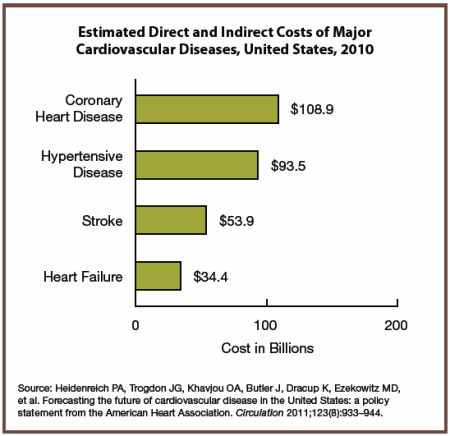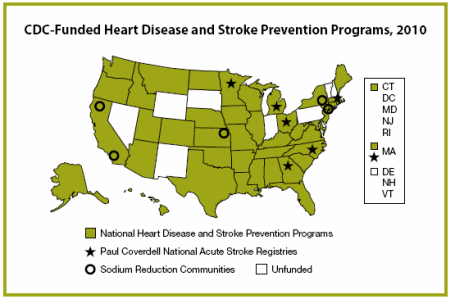Heart Disease and Stroke Prevention
Addressing the Nation's Leading Killers: At A Glance 2011

On this Page
Heart Disease and Stroke: The Nation’s Leading Killers
Heart disease and stroke, the first and third leading causes of death for men and women, are among the most widespread and costly health problems facing our nation today, yet they also are among the most preventable. Cardiovascular diseases, including heart disease and stroke, account for more than one-third (33.6%) of all U.S. deaths.
In 2007, of all Americans who died of cardiovascular diseases, 150,000 were younger than age 65. Heart disease and stroke also are among the leading causes of disability in the United States, with nearly 4 million people reporting disability from these causes.
The Costs of Disease Are Staggering
Death rates alone cannot describe the burden of heart disease and stroke. In 2010, the total costs of cardiovascular diseases in the United States were estimated to be $444 billion. Treatment of these diseases accounts for about $1 of every $6 spent on health care in this country. As the U.S. population ages, the economic impact of cardiovascular diseases on our nation's health care system will become even greater.
Overall, death rates for heart disease and stroke have decreased in the United States in recent decades. However, rates for incidence and death continue to be high, especially among some populations, including members of certain racial and ethnic groups, people with low socioeconomic status, and those living in the southeastern United States.
For example, age-adjusted death rates for cardiovascular disease are 37% higher among African Americans than among whites. The risk of having a first-ever stroke is nearly two times higher among African Americans than among whites. In addition, about 55,000 more women than men have a stroke each year. Recent studies show that the prevalence of heart disease and the percentage of associated premature deaths are higher among American Indians and Alaska Natives than among any other U.S. racial or ethnic group.
The Cost of Heart Disease and Stroke
- More than 1 of 3 (83 million) U.S. adults currently lives with one or more types of cardiovascular disease.
- An estimated 935,000 heart attacks and 795,000 strokes occur each year.
- Nearly 68 million adults have high blood pressure, and about half do not have this condition under control.
- An estimated 71 million adults have high cholesterol (i.e., high levels of low-density lipoprotein cholesterol). Nearly 2 of 3 do not have this condition under control.
Prevention Saves Lives
Leading a healthy lifestyle—not using tobacco, being physically active, maintaining a healthy weight, and making healthy food choices—greatly reduces a person's risk of developing heart disease or stroke. Preventing and controlling high blood pressure and high cholesterol also play a significant role in cardiovascular health. For example, a 12–13 point reduction in average systolic blood pressure over 4 years can reduce heart disease risk by 21%, stroke risk by 37%, and risk of total cardiovascular death by 25%. Public health strategies and policies that promote healthy living, encourage healthy environments, and promote control of blood pressure and cholesterol levels are vital to improving the public's health and saving lives. Ensuring that all Americans have access to early, affordable, and appropriate treatment also is essential to reducing disability and costs.
CDC’s Response
Through the Division for Heart Disease and Stroke Prevention, CDC translates prevention research into public health practice and provides national and state leadership to help reduce the burden of heart disease and stroke. CDC has funded heart disease and stroke prevention programs in the United States since 1998. With $56.2 million in Fiscal Year 2010, CDC funded health departments in 41 states and the District of Columbia to conduct heart disease and stroke prevention programs, 6 states to continue their Paul Coverdell National Acute Stroke Registry programs, and 5 sites to support sodium reduction efforts. CDC also funds national data collection, applied research, and evaluation initiatives. CDC's work is grounded in goals and strategies set forth in Healthy People 2020, the Division for Heart Disease and Stroke Prevention's strategic plan, and A Public Health Action Plan to Prevent Heart Disease and Stroke.
State Activities Supported by CDC Funding
- Working with primary care providers, health plans, and others to make system changes that help increase the number of people who lower their blood pressure. Activities include implementing automated reminders from providers to patients and creating electronic patient management systems.
- Promoting policies that help communities create healthier food environments and reduce sodium intake among residents.
- Promoting heart-healthy and stroke-free policies and programs in the workplace, such as smoke-free work sites, wellness programs, and insurance coverage of preventive health services for employees.
- Coordinating stroke prevention efforts to ensure that systems of care provide the highest quality of stroke care for all patients.
- Promoting training, standard protocols, and electronic reporting systems for emergency medical services personnel.
ABCS Initiative
High blood pressure, high cholesterol, and smoking continue to put more people at risk of heart disease and stroke. To address these risk factors, CDC is focusing on the ABCS of heart disease and stroke prevention—appropriate Aspirin therapy, Blood pressure control, Cholesterol control, and Smoking cessation.
National Heart Disease and Stroke Prevention Program
CDC-funded state programs promote changes to policies and systems in health care, work site, and community settings and elimination of health disparities by emphasizing the ABCS of heart disease and stroke prevention. Some programs also work to improve emergency response and quality of acute care.
Paul Coverdell National Acute Stroke Registry
CDC's Paul Coverdell National Acute Stroke Registry program helps to improve the delivery and quality of care for acute stroke patients by identifying gaps between recommended treatment guidelines and actual hospital practices. CDC currently funds programs in Georgia, Massachusetts, Michigan, Minnesota, North Carolina, and Ohio.
In 2007, CDC partnered with the American Heart Association (AHA) and The Joint Commission to develop performance measures for acute stroke care. These measures are now core measures for the Paul Coverdell National Acute Stroke Registry; The Joint Commission's hospital accreditation program; the AHA Get With The Guidelines program; and stage 1 of the Centers for Medicare & Medicaid Services program to promote the meaningful use of certified electronic health record technology, which began in 2011. The measures are used in more than 1,400 hospitals that participate in one of these programs. This effort will reduce duplication, increase collaboration, and encourage hospitals to participate in these programs to improve the care of stroke patients.
Sodium Reduction Initiative
Eating too much sodium is a major contributor to high blood pressure, and the majority of the sodium that people eat comes from processed and restaurant foods. Policy and environmental changes can help decrease sodium intake and have immediate, positive effects on a person's blood pressure. CDC is working to reduce sodium intake by promoting local, state, and national strategies; meeting with public and private stakeholders; enhancing the monitoring of sodium intake and changes in the food supply; and expanding scientific literature on sodium.
In September 2010, CDC began funding sodium reduction efforts in California (working with Shasta County), Kansas (working with Shawnee County), Los Angeles County, New York City, and New York State (working with Broome and Schenectady counties). This 3-year project will support policy changes designed to create healthier food environments and make it easier for people to eat less sodium.
Better Tracking of Cardiovascular Disease
Researchers are currently unable to accurately estimate the annual incidence for heart disease or stroke or the prevalence of their risk factors at state or local levels. A comprehensive, national surveillance system that provides timely local data is needed. Such a system would improve capacity to monitor risk factor trends, identify populations at greatest risk, and evaluate the effect of efforts to control risk factors for cardiovascular disease.
CDC Activities Support State Programs
CDC also conducts the following activities to help prevent heart disease and stroke at state and local levels:
- Evaluation. CDC conducts evaluation research and helps states evaluate the effectiveness of prevention programs and policy and system-level changes.
- Monitoring and Tracking Disease. CDC tracks data and trends in heart disease and stroke to help states make informed program decisions.
- Training and Technical Assistance. CDC provides guidance and training to states and partners on how to apply evidence-based practices and develop effective programs.
- Translating Science into Practice. CDC interprets the science of prevention and translates it into practices and programs for states and communities.
- Partnerships. CDC builds partnerships with other federal agencies and national groups, such as the Federal Interagency Committee on Emergency Medical Services, to promote policies and system improvements to prevent heart disease and stroke across the country.
Cardiac Arrest Registry to Enhance Survival
The Cardiac Arrest Registry to Enhance Survival (CARES) program, which began in 2004, is a database that communities across the United States can use to identify out-of-hospital cardiac arrest events, measure key aspects of prehospital care, determine rates of survival, and improve emergency cardiac care. In 2011, CARES participants include 40 communities in 25 states, with state-level expansion planned for 7 states.
Heart Disease and Stroke
Prevention Programs Are Making a Difference in Health Outcomes
Success Stories
Improving Clinical Preventive Services to Reduce High Blood Pressure in Kansas
Having high blood pressure increases a person's risk of heart disease and stroke. In 2005, 24.2% of Kansas adults aged 18 years or older reported that they had high blood pressure. The prevalence is even higher among older age groups, with one-third of adults aged 45–64 years and about half of those aged 65 years or older reporting high blood pressure. Among all adults with high blood pressure in Kansas, 19.6% said they were not taking any medication to control this condition.
To help improve the quality of health care for people with high blood pressure in Kansas, officials in the state's Heart Disease and Stroke Prevention Program and the Diabetes Quality of Care Project formed the Kansas Quality of Care Project in 2007. As part of this project, 13 clinics throughout the state received guidelines and educational materials for patients on how to prevent and manage high blood pressure. The clinics also received assistance and training on how to improve the quality of the data they collect, use these data to identify barriers to care and gaps in services, link patients to community resources, and share success stories.
In 2009, 11 clinics submitted data for 2,303 patients with high blood pressure (1,449 without diabetes, 854 with diabetes). The data showed that the percentage of patients without diabetes who had their blood pressure under control increased from 54.6% in 2007 to 63.0% in 2009. Increases also were reported in the percentage of clinics that were referring patients with high blood pressure to behavior-change and peer-support programs (from 69.2% to 75.0%) and that were distributing guidelines on physical activity and blood pressure control to patients (from 69.2% to 75.0%). In addition, the data showed that 98% of all project participants with high blood pressure had their blood pressure measured during at least one clinic visit in 2009, and 84% were taking medication to control this condition.
Doctors who participated in the Kansas Quality of Care Project reported that the project made them more aware of the importance of following treatment guidelines and developing policies to help patients better manage their blood pressure.
Collaborating to Control High Blood Pressure in Community Health Centers in Montana
Controlling blood pressure is an important way to reduce a person's risk of dying from a heart attack or stroke. In 2007, health officials in Montana's Cardiovascular Health Program implemented a program to help state residents with high blood pressure get it under control. They focused on low-income people who receive services from federally funded Community Health Centers. Clinic staff educated patients about high blood pressure, taught them how to monitor their blood pressure at home, reviewed the measurements recorded by patients at home, and adjusted medications when needed.
The goal was to increase the percentage of Community Health Center patients who have their blood pressure under control from 46.7% to 50% by June 2010. The program was implemented in nine Community Health Centers and one satellite clinic. During the 3-year program, 1,676 patients participated (712 with high blood pressure and diabetes and 964 with high blood pressure and no diabetes). The average age of the patients was 57 years; 58% were women, most were white, and 41% did not have health insurance. Of the 1,676 patients who participated in the program, 607 received blood pressure kits that included an automated blood pressure cuff, educational materials, and a pedometer. To receive a kit, patients with uncontrolled high blood pressure had to agree to check their blood pressure at home weekly.
An evaluation of the program in June 2010 found that the overall goal had been met: 50.2% of participants had their blood pressure under control. Control rates increased from 33% to 42% for patients with diabetes and from 56% to 62% for those with no diabetes. Control rates for patients with uncontrolled high blood pressure who received blood pressure kits increased from 0% to 47%. The average blood pressure of patients who received blood pressure kits also decreased.
The success of this program prompted officials in Montana's Cardiovascular Health Program to offer additional blood pressure monitors and patient educational materials through participating Community Health Centers as a way to help more patients in the future. These resources will help to sustain the project for years to come.
Funding for New Trauma Care System Will Improve Heart Attack and Stroke Response in Michigan
Until recently, Michigan was one of only three states without a funded trauma care system. Despite passage of legislation and rules to support such a system in 2004 and 2007, no funding was allocated to hire and train staff, set up a registry to collect patient data, and implement programs.
In 2007, CDC provided funding to Michigan to help improve emergency care for people who suffer heart attacks or strokes. Staff members working in the area of heart disease and stroke prevention in the Michigan Department of Community Health (MDCH) used this funding to conduct the following activities:
- Assess how the state's existing emergency medical services (EMS) systems respond to cardiac and stroke emergencies. Assessments were conducted in 2008 and 2010 to establish a baseline and identify where improvements were needed. Findings were used to identify priority activities and track progress.
- Attend regional trauma network meetings to discuss ways to improve care for heart attack and stroke victims.
- Work with state EMS officials to update the state's heart attack and stroke protocols to match national guidelines.
- Create a train-the-trainer program for stroke emergency response.
- Sponsor a statewide conference that focused on a regional model for emergency care.
- Distribute 6,000 cards to EMS providers that provided clinical information and prompts about how to respond to heart attacks and strokes.
These activities helped state health officials collect evidence to support the need for a regional, funded trauma care system that will be the foundation for stroke and cardiac systems of care. CDC funding also helped MDCH staff members build a strong relationship with state EMS leaders and other partners.
In December 2010, the state enacted a law to fund a trauma care system in Michigan. This funding will provide the resources needed to implement a regional system that includes planning for heart attack and stroke emergencies. Every state resident, visitor, health care professional, and EMS provider who uses or works in the new trauma care system will benefit.
For more information please contact the
Centers for Disease
Control and Prevention
National Center for Chronic Disease Prevention and Health Promotion
4770 Buford Highway NE, Mail Stop K-47, Atlanta, GA 30341-3717
Telephone: 800-CDC-INFO (232-4636) • TTY: 888-232-6348
E-mail: cdcinfo@cdc.gov • Web:
http://www.cdc.gov/dhdsp
Contact Us:
- Centers for Disease Control and Prevention
National Center for Chronic Disease Prevention and Health Promotion (NCCDPHP)
4770 Buford Hwy, NE
MS K-40
Atlanta, GA 30341-3717 - 800-CDC-INFO
(800-232-4636)
TTY: (888) 232-6348
8am-8pm ET
Monday-Friday
Closed Holidays - Contact NCCDPHP






